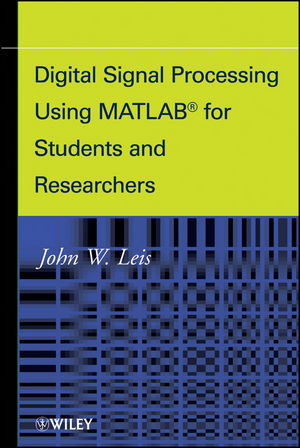
Digital Signal Processing Using MATLAB for Students and Researchers
John Wiley & Sons Inc (Verlag)
978-0-470-88091-3 (ISBN)
- Lieferbar (Termin unbekannt)
- Versandkostenfrei innerhalb Deutschlands
- Auch auf Rechnung
- Verfügbarkeit in der Filiale vor Ort prüfen
- Artikel merken
With its active, hands-on learning approach, this text enables readers to master the underlying principles of digital signal processing and its many applications in industries such as digital television, mobile and broadband communications, and medical/scientific devices. Carefully developed MATLAB® examples throughout the text illustrate the mathematical concepts and use of digital signal processing algorithms. Readers will develop a deeper understanding of how to apply the algorithms by manipulating the codes in the examples to see their effect. Moreover, plenty of exercises help to put knowledge into practice solving real-world signal processing challenges.
Following an introductory chapter, the text explores:
Sampled signals and digital processing
Random signals
Representing signals and systems
Temporal and spatial signal processing
Frequency analysis of signals
Discrete-time filters and recursive filters
Each chapter begins with chapter objectives and an introduction. A summary at the end of each chapter ensures that one has mastered all the key concepts and techniques before progressing in the text. Lastly, appendices listing selected web resources, research papers, and related textbooks enable the investigation of individual topics in greater depth.
Upon completion of this text, readers will understand how to apply key algorithmic techniques to address practical signal processing problems as well as develop their own signal processing algorithms. Moreover, the text provides a solid foundation for evaluating and applying new digital processing signal techniques as they are developed.
John Leis, PhD, is Associate Professor of Electrical and Computer Engineering at the University of Southern Queensland. He has authored many technical papers in areas involving signal processing and networking. Dr. Leis's interests include signal processing for data compression and coding, medical signal processing, and advanced instrumentation using signal processing algorithms. He has collaborated internationally on various research projects. Dr. Leis has taught the subject material extensively in Australia and also Singapore. He is a Senior Member of the Institution of Electrical & Electronic Engineers and a Member of the Association for Computing Machinery.
Preface xi Chapter 1. What Is Signal Processing? 1
1.1 Chapter Objectives 1
1.2 Introduction 1
1.3 Book Objectives 2
1.4 DSP and ITS Applications 3
1.5 Application Case Studies Using DSP 4
1.6 Overview of Learning Objectives 12
1.7 Conventions Used in This Book 15
1.8 Chapter Summary 16
Chapter 2. Matlab for Signal Processing 19
2.1 Chapter Objectives 19
2.2 Introduction 19
2.3 What Is MATLAB? 19
2.4 Getting Started 20
2.5 Everything Is a Matrix 20
2.6 Interactive Use 21
2.7 Testing and Looping 23
2.8 Functions and Variables 25
2.9 Plotting and Graphing 30
2.10 Loading and Saving Data 31
2.11 Multidimensional Arrays 35
2.12 Bitwise Operators 37
2.13 Vectorizing Code 38
2.14 Using MATLAB for Processing Signals 40
2.15 Chapter Summary 43
Chapter 3. Sampled Signals and Digital Processing 45
3.1 Chapter Objectives 45
3.2 Introduction 45
3.3 Processing Signals Using Computer Algorithms 45
3.4 Digital Representation of Numbers 47
3.5 Sampling 61
3.6 Quantization 64
3.7 Image Display 74
3.8 Aliasing 81
3.9 Reconstruction 84
3.10 Block Diagrams and Difference Equations 88
3.11 Linearity, Superposition, and Time Invariance 92
3.12 Practical Issues and Computational Efficiency 95
3.13 Chapter Summary 98
Chapter 4. Random Signals 103
4.1 Chapter Objectives 103
4.2 Introduction 103
4.3 Random and Deterministic Signals 103
4.4 Random Number Generation 105
4.5 Statistical Parameters 106
4.6 Probability Functions 108
4.7 Common Distributions 112
4.8 Continuous and Discrete Variables 114
4.9 Signal Characterization 116
4.10 Histogram Operators 117
4.11 Median Filters 122
4.12 Chapter Summary 125
Chapter 5. Representing Signals and Systems 127
5.1 Chapter Objectives 127
5.2 Introduction 127
5.3 Discrete-Time Waveform Generation 127
5.4 The z Transform 137
5.5 Polynomial Approach 144
5.6 Poles, Zeros, and Stability 146
5.7 Transfer Functions and Frequency Response 152
5.8 Vector Interpretation of Frequency Response 153
5.9 Convolution 156
5.10 Chapter Summary 160
Chapter 6. Temporal and Spatial Signal Processing 165
6.1 Chapter Objectives 165
6.2 Introduction 165
6.3 Correlation 165
6.4 Linear Prediction 177
6.5 Noise Estimation and Optimal Filtering 183
6.6 Tomography 188
6.7 Chapter Summary 201
Chapter 7. Frequency Analysis of Signals 203
7.1 Chapter Objectives 203
7.2 Introduction 203
7.3 Fourier Series 203
7.4 How Do the Fourier Series Coefficient Equations Come About? 209
7.5 Phase-Shifted Waveforms 211
7.6 The Fourier Transform 212
7.7 Aliasing in Discrete-Time Sampling 231
7.8 The FFT as a Sample Interpolator 233
7.9 Sampling a Signal over a Finite Time Window 236
7.10 Time-Frequency Distributions 240
7.11 Buffering and Windowing 241
7.12 The FFT 243
7.13 The DCT 252
7.14 Chapter Summary 266
Chapter 8. Discrete-Time Filters 271
8.1 Chapter Objectives 271
8.2 Introduction 271
8.3 What Do We Mean by “Filtering”? 272
8.4 Filter Specification, Design, and Implementation 274
8.5 Filter Responses 282
8.6 Nonrecursive Filter Design 285
8.7 Ideal Reconstruction Filter 293
8.8 Filters with Linear Phase 294
8.9 Fast Algorithms for Filtering, Convolution, and Correlation 298
8.10 Chapter Summary 311
Chapter 9. Recursive Filters 315
9.1 Chapter Objectives 315
9.2 Introduction 315
9.3 Essential Analog System Theory 319
9.4 Continuous-Time Recursive Filters 326
9.5 Comparing Continuous-Time Filters 339
9.6 Converting Continuous-Time Filters to Discrete Filters 340
9.7 Scaling and Transformation of Continuous Filters 361
9.8 Summary of Digital Filter Design via Analog Approximation 371
9.9 Chapter Summary 372
Bibliography 375
Index 379
| Verlagsort | New York |
|---|---|
| Sprache | englisch |
| Maße | 164 x 234 mm |
| Gewicht | 697 g |
| Themenwelt | Mathematik / Informatik ► Informatik |
| Technik ► Elektrotechnik / Energietechnik | |
| Technik ► Nachrichtentechnik | |
| ISBN-10 | 0-470-88091-0 / 0470880910 |
| ISBN-13 | 978-0-470-88091-3 / 9780470880913 |
| Zustand | Neuware |
| Informationen gemäß Produktsicherheitsverordnung (GPSR) | |
| Haben Sie eine Frage zum Produkt? |
aus dem Bereich


